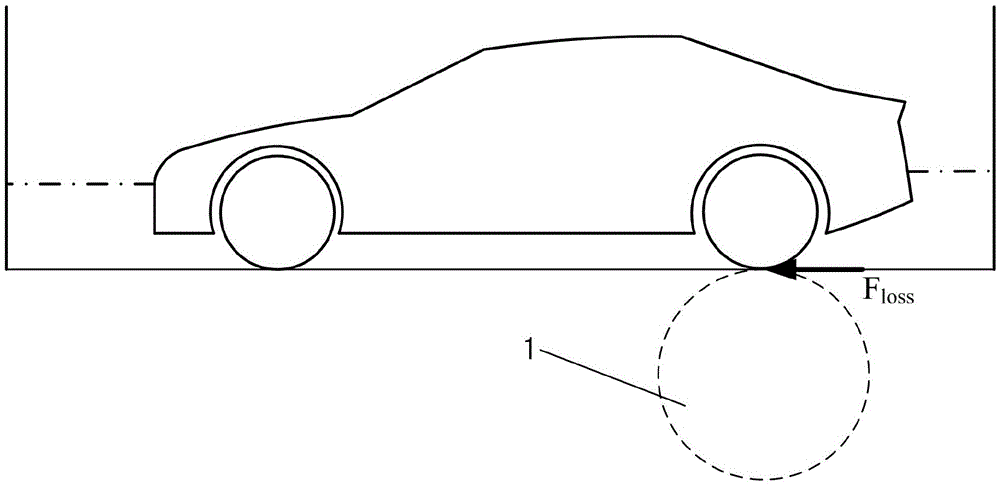Parking performance test device for passenger car on rotating hub test stand and application thereof
A test device and test bench technology, applied in the direction of measurement device, vehicle test, machine/structural component test, etc., can solve the problem that the structure design and optimization of the parking brake system cannot provide data support, and the parking brake force cannot be tested. , the data is not analyzable, etc.
- Summary
- Abstract
- Description
- Claims
- Application Information
AI Technical Summary
Problems solved by technology
Method used
Image
Examples
Embodiment 1
[0065] Embodiment 1: A test device for parking performance of a passenger car on a hub test bench, comprising: a hub test bench 1, a force sensor 2 and an angular displacement sensor 4;
[0066] Such as figure 1 As shown, the passenger car is fixed on the hub test bench 1, and fixed according to the usage specification of the hub test bench, the accuracy of the test force of the hub test bench is 0.25%, and the accuracy of the test speed is 0.1km / h. Such as figure 2 and image 3 As shown, the hand-held end of the parking brake lever 3 of the passenger car is fixed with a force sensor 2 through a bracket. The force sensor is a sensor from the German HKM company. The power supply voltage is 10.5-25VDC, and the output signal is 0-5V analog. The test range is 0-500N, and the test accuracy is less than 0.5% FS. In order to accurately and truly measure the driver's operating force, it is necessary to ensure that the longitudinal symmetry plane B of the force sensor 2 coincides w...
Embodiment 2
[0068] Embodiment 2: as Figure 9 As shown, a method for testing the parking performance of a passenger car on a hub test bench is carried out in the following steps:
[0069] 2.1. An angular displacement sensor 4 is fixedly installed on the side of the parking brake lever 3 of the passenger car; Figure 8 As shown, the angular displacement sensor 4 is used to calibrate the angle of the pawl 5 matched with the bottom of the parking brake lever 3 on a flat road surface, and the angle of the kth tooth in the pawl 5 is obtained, which is denoted as 0≤k≤α; α represents the total number of teeth of the ratchet 5;
[0070] 2.2. A force sensor 2 is fixed on the hand-held end of the parking brake lever 3 through a bracket to obtain the driver's operating force;
[0071] 2.3. A passenger car is fixedly installed on the hub test bench 1, and the mode of the hub test bench 1 is set to road mode, and the sliding resistance of the hub test bench 1 is set to match that of the passenger c...
Embodiment 3
[0089]Embodiment 3, a method for evaluating the parking performance of a passenger car on a hub test bench is carried out as follows:
[0090] Step 1. Define variable k, 1≤k≤α;
[0091] Step 2, evaluating the parking performance of the kth tooth;
[0092] Step 3. Calculate the mean wheel edge force at the 0th tooth
[0093] Step 4. Based on the kth gear edge force set Extract the set of minimum wheel edge forces for each rotation of the wheel and the set of maximum wheel edge force
[0094] Step 5. Calculate the mean value of the minimum wheel edge force and the mean maximum wheel edge force
[0095] Step 6. Using formula (2) and formula (3) to calculate the equivalent standing slope range [θ k-min ,θ k-max ];
[0096] θ k - m i n = t a n ( a r c ...
PUM
 Login to View More
Login to View More Abstract
Description
Claims
Application Information
 Login to View More
Login to View More - R&D
- Intellectual Property
- Life Sciences
- Materials
- Tech Scout
- Unparalleled Data Quality
- Higher Quality Content
- 60% Fewer Hallucinations
Browse by: Latest US Patents, China's latest patents, Technical Efficacy Thesaurus, Application Domain, Technology Topic, Popular Technical Reports.
© 2025 PatSnap. All rights reserved.Legal|Privacy policy|Modern Slavery Act Transparency Statement|Sitemap|About US| Contact US: help@patsnap.com



